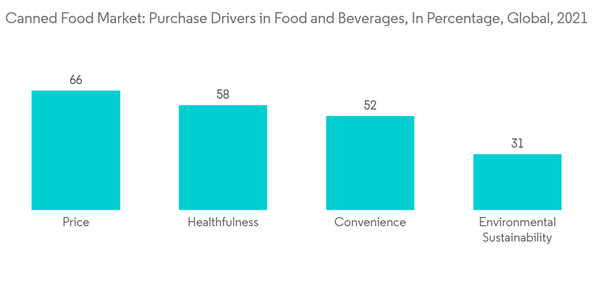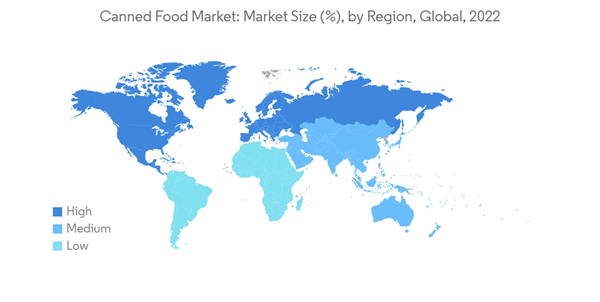Canning is the process of preserving food products and extending their shelf life. Canned products are used in many countries in extensive quantities owing to their benefits. Canned foods reduce the spoilage of food because of external factors like sunlight, air, or insects. Canning preserves the nutrients of the food as it is. Many fast-food chains and restaurants use canned foods like corn, tomato purees, and many more owing to their convenience and longer shelf life. Major players like Campbell's, Del Monte, Nestle, and many other companies relaunch their older products with new packaging or logos to attract consumers' attention. For instance, in November 2021, Campbell Soups relaunched its Campbell's Condensed Soup with a new logo, packaging, and visual identity.
The market is mainly driven by the rising urban population that prefers easy and convenient food and the demand for healthy food rich in protein, functional fibers, vitamins, and omega-3 fatty acids. Consumers who are willing to spend a little more for the products offering such properties, coupled with the demand for small, easy, ready-to-cook meat and seafood and organic canned fruits and vegetables, are thus fueling market sales. Furthermore, the rising awareness of the ills of plastic packaging and the demand for a sustainable solution, as well as the increasing recycling rates globally, have been further driving the market. The rising number of food retail outlets, along with increasing urbanization, research and development investments, and marketing strategies used by the players in the canned food market, is expected to have a positive effect on the overall revenue of the global canned food market.
Canned Food Market Trends
Increasing Demand for Convenience Food
Convenience is the key factor driving the growth of canned food consumption across the world, coupled with increasing disposable income and the rising number of working women. Because of their hectic lifestyles, consumers' preference for convenience food products has grown in recent years. Due to the retention of high amounts of nutrients, color, and flavor, canned foods have become one of the most preferred preserved foods among consumers. Changes in lifestyles, coupled with increased expenditure on food and beverages, lead to a significant dietary transition among consumers, marked by increased demand for animal-sourced food, fats and oils, refined grains, and fruits and vegetables.People with busy life schedules, especially those who lack cooking skills, fatigue due to the fast lifestyle. Changes in consumers' demography are the major factors driving the convenience foods market. The market sentiments for food and beverages indicate a strong correlation between the sales of food and the degree of convenience they offer. Canned foods are purchased based on several factors. However, the most important among them is convenience. Convenience is also regarded as a major value addition for all canned foods.
Europe Dominates the Global Canned Food Market
Canned food in terms of meat, fish, vegetables, and fruits is commonly preferred by consumers in the market, as consumers prefer to minimize the retail place visits of meat and fish and store these products in their households. Owing to the demand for these products, the country happens to be one of the leading processed vegetable and fruit importers among European countries. For instance, in 2021, according to Eurostat, Germany imported 26% of total canned beans imported by volume into Europe. By value, it imported about EUR 114.1 million worth of canned beans into Germany in 2021.With increasingly busy lifestyles among consumers in the market, products with convenience are being preferred by consumers. Canned food products such as fruits and vegetables are frequently purchased by consumers in supermarkets and convenience stores. Tomato purees, pastes, and canned pickled vegetables are often used in various cuisine recipes that are commonly consumed across different countries in Europe.
Canned Food Industry Overview
The global market for canned food is highly competitive, owing to the presence of large regional and domestic players. Major players in the market include Del Monte Foods Inc., Conagra Brands Inc., Kraft Heinz Company, Campbell Soup Company, Nestlé S.A., etc., among others. Companies in the canned food market are investing in product development by strengthening their research and development initiatives for the long term. The key players have also been focusing on the sustainable production of canned food products to entice more consumers.Additional Benefits:
- The market estimate (ME) sheet in Excel format
- 3 months of analyst support
This product will be delivered within 2 business days.
Table of Contents
Companies Mentioned (Partial List)
A selection of companies mentioned in this report includes, but is not limited to:
- Campbell Soup Company
- Conagra Brands Inc.
- Del Monte Pacific Limited
- The Bolton Group
- Kraft Heinz Company
- Bonduelle SA
- JBS S.A. (SAMPCO)
- Thai Union Group PCL
- Dole Holding Company LLC
- Century Pacific Food Inc.










